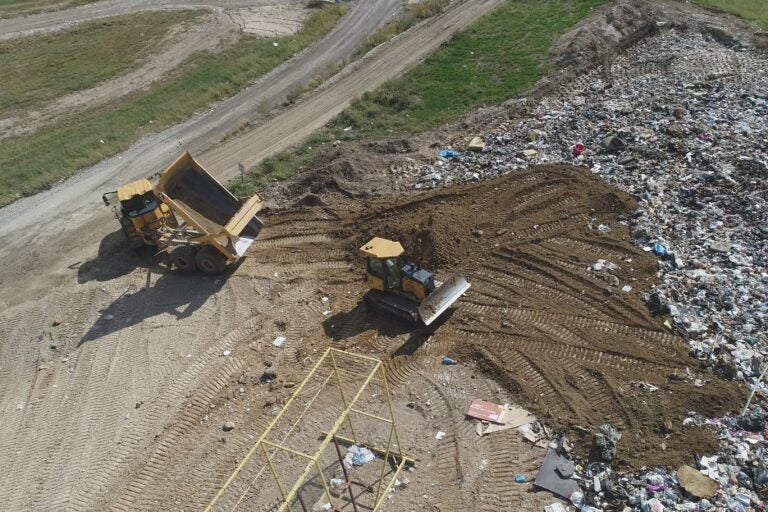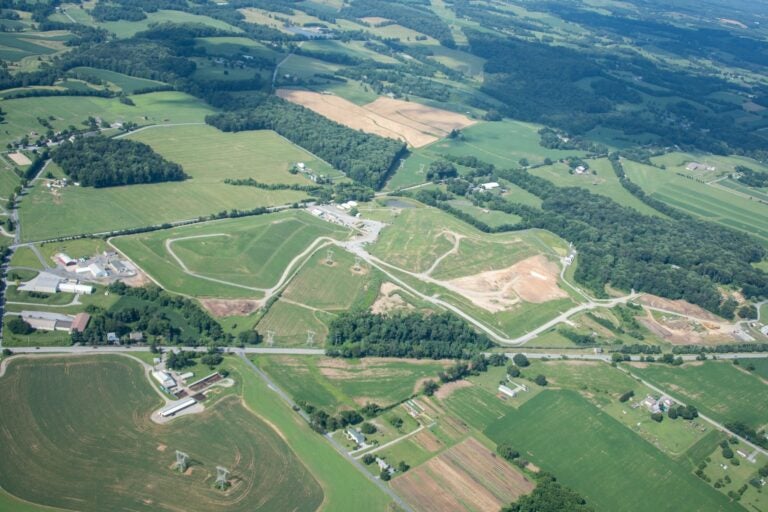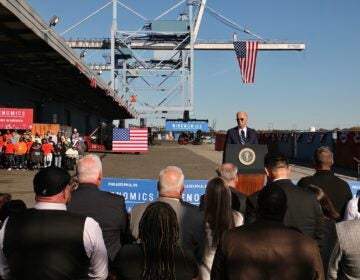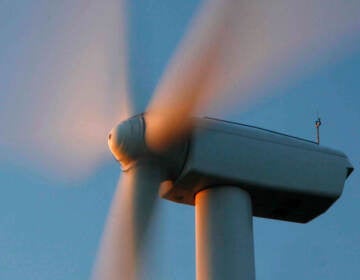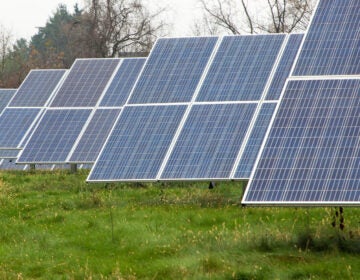French energy company to produce renewable natural gas from Chester County landfill waste
Landfills are responsible for more than 14% of human-caused methane emissions. Owners and energy companies are using technology to turn methane into renewable natural gas.
Listen 1:15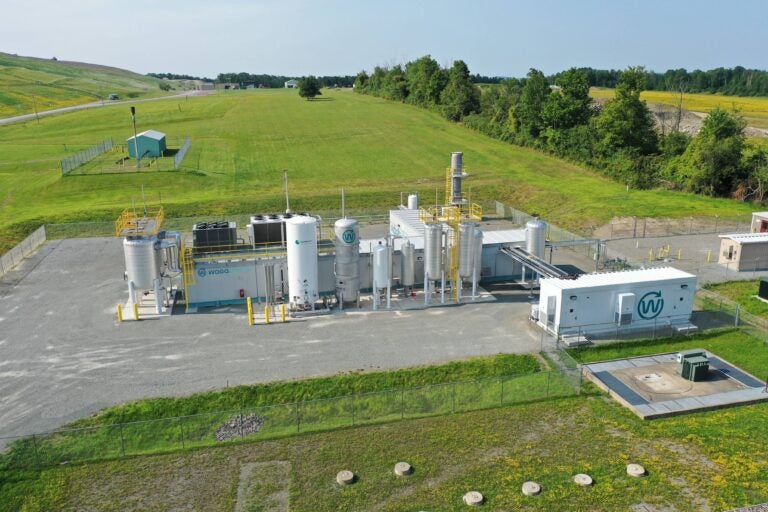
Waga Energy WAGABOX (right) unit of RNG production at Bath Landfill, Steuben County, N.Y. (Courtesy of Waga Energy)
This story is part of the WHYY News Climate Desk, bringing you news and solutions for our changing region.
From the Poconos to the Jersey Shore to the mouth of the Delaware Bay, what do you want to know about climate change? What would you like us to cover? Get in touch.
Landfills are a significant contributor to climate change, as degraded waste emits harmful methane gas. Increasingly, landfill owners and energy companies have aimed to reduce emissions by converting methane into sellable renewable natural gas.
A Chester County landfill is jumping on the bandwagon. The Southeastern Chester County Refuse Authority, or SECCRA, is partnering with French company Waga Energy to produce renewable natural gas from degraded waste in an effort to reduce methane emissions and heat more than 4,000 homes.
The municipal authority in West Grove serves about 105,000 Chester County residents who generate about 450 to 500 tons of trash per day.
“No one wants a landfill in their backyard. So, we do what we can to make sure that we fit in as easily as possible and also do some good things for the environment,” said general manager Scott Mengle. “Yes, it stinks to throw your stuff away, but … they are actually going to get put to good use here.”
Landfills are responsible for more than 14% of human-caused methane emissions, making it the third-largest source, according to the U.S. Environmental Protection Agency.
The greenhouse gas traps more heat in the atmosphere than carbon dioxide, so climate scientists say reducing methane emissions could help mitigate global warming.
The EPA requires landfills of a certain size to prevent methane emissions by using gas-trapping technology. However, landfills continue to persistently emit methane, and current leak detection methods are flawed, according to studies.
Rather than merely eliminate emissions at landfills, several operators are partnering with energy companies that convert biogas into a usable energy source, which they can sell to utilities while seeking federal tax incentives aimed to bolster eco-friendly energy projects.
Renewable natural gas projects at landfills are often considered “green,” because they capture methane, a climate-warming greenhouse gas, convert it into a usable energy source and ultimately reduce methane emissions, said Sahadat Hossain, a civil engineering professor and director of the Solid Waste Institute for Sustainability at the University of Texas, Arlington.
“If you capture the landfill gas and convert it into energy, you are capturing all the gas, otherwise which is going to be released into the environment. So, it reduces the greenhouse gas emission and it converts a liability into an asset,” he said. “If we release it into the environment, it’s a liability for the environment and for the landfill. If you capture it and convert it into energy, that means what could have been liability becomes your asset.”
Since 2007, SECCRA has produced electricity for 1,400 homes by capturing the methane that comes from degraded landfill trash. However, not only is the system aging, it also releases emissions because it involves combusting electricity in an engine, which relies on fossil fuels.
The Waga Energy technology, which doesn’t involve a combustion process, aims to reduce harmful emissions. The technology vacuums methane out of landfills, purifies the gas and sends it to the gas grid through a pipeline.
Counter to the current project, which generates electricity that makes its way to power lines, the new project involves producing gas that will be sent to pipelines that ultimately heat peoples’ homes. Waga Energy and SECCRA hope to partner with energy company PECO, which owns an already-existing pipeline that runs alongside the landfill.
The renewable natural gas would be distributed from PECO’s gas grid to heat 4,400 homes — three times the number of households served by the landfill’s current methane-to-electricity project. Waga Energy and SECCRA estimate the new project, estimated for completion in 2026, hopes to eliminate about 15,000 tons of CO2 per year.
“We know how to deal with [methane] pollution, which is to destroy it — but by doing so, you do not recover the energy,” said Guénaël Prince, U.S. CEO of Waga Energy. “By being able to recover that pollution, turning that pollution into energy, we avoid releasing methane directly into the atmosphere, and we produce a green energy that is valuable, that is cheap, and our view of renewable energy is that it should be affordable.”
PECO said it is unable to comment on the details of the project because feasibility studies and negotiations are ongoing.
“This effort is part of PECO’s broader commitment to protect and preserve the environment and combat climate change, by playing a leading role in the greater Philadelphia region’s transition to a cleaner energy future,” a spokesperson said in a statement.
Federal tax incentives available to Waga Energy and other companies aiming to reduce the carbon footprint have helped boost renewable natural gas projects, Hossain said. According to the EPA, about 20% of operating landfill gas energy projects are producing renewable natural gas.
However, the future of renewable energy initiatives remains uncertain as President Donald Trump calls for increased reliance on fossil fuels. It is yet to be seen whether renewable energy tax credits would be impacted by the Trump administration’s policies.
Are all RNG projects green?
Debate has spurred about whether renewable natural gas is a real climate solution. Studies have found that potential renewable natural gas leaks can be as harmful as coal, and some skeptics have questioned the viability of its longevity.
Hussain said the environmental benefits of producing renewable natural gas depends heavily on the process. Projects that incinerate waste to generate energy can emit dioxins and other contaminants into the environment, impacting the health of people who live nearby — often disproportionately harming low-income residents and people of color.
Hossain said he agrees with critics who call these renewable energy projects “greenwashing.” Though filters are available to reduce the environmental impact, the technology is expensive and landfill operators don’t always use them or adhere to regulations, he said.
On the other hand, gas to energy projects such as the one planned in Chester County are legitimate climate solutions because they purify the biogas and don’t involve an incineration process, Hossain said.
He said if SECCRA educates residents about the environmental benefits of the project, they are also more likely to make an effort to separate their trash and recycling correctly.
“If they know their energy is not coming from a fossil fuel source, but a renewable energy source, it will make them very happy,” Hossain said. “So, there is a satisfaction factor which comes under the social awareness campaign.”

Get daily updates from WHYY News!
WHYY is your source for fact-based, in-depth journalism and information. As a nonprofit organization, we rely on financial support from readers like you. Please give today.



